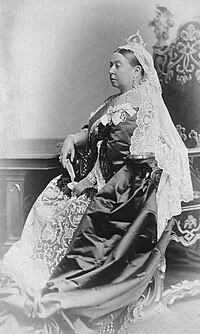Our website is made possible by displaying online advertisements to our visitors.
Please consider supporting us by disabling your ad blocker.
Victorian era

| |
| Queen Victoria, after whom the Victorian period is named.
1837 - 1901 | |
| Preceded by | Georgian era |
|---|---|
| Followed by | Edwardian period |
The Victorian era of the United Kingdom was a time of Queen Victoria's rule from 1837 to 1901.[1] This time was very prosperous for the British people. Trade was at its best. A well educated middle class ruled the country and the British Empire. Other countries also prospered but Britain became the greatest great power.
The Industrial Revolution continued to increase productivity and prosperity, especially in the middle and later parts of Victoria's reign. Making iron and steel was a basic industry. The furnaces were fired with coal. Shipbuilding was a major industry. Canals and steam railways connected all parts of the country, and British steamships connected the world. Cotton and wool were made into cloth and exported. Ceramics were also a major industry.
One important change in the Victorian era was the creation of the sewage system in London. In 1829 photography was invented. Gas lighting was important too. Streetlights became common first, followed by lights in public buildings and home. In the 1880s people began making power stations and distribution systems to feed the new electric lightbulbs.
- ↑ Swisher, Clarice (ed) 2000. Victorian England. San Diego, CA : Greenhaven Press.
Previous Page Next Page


